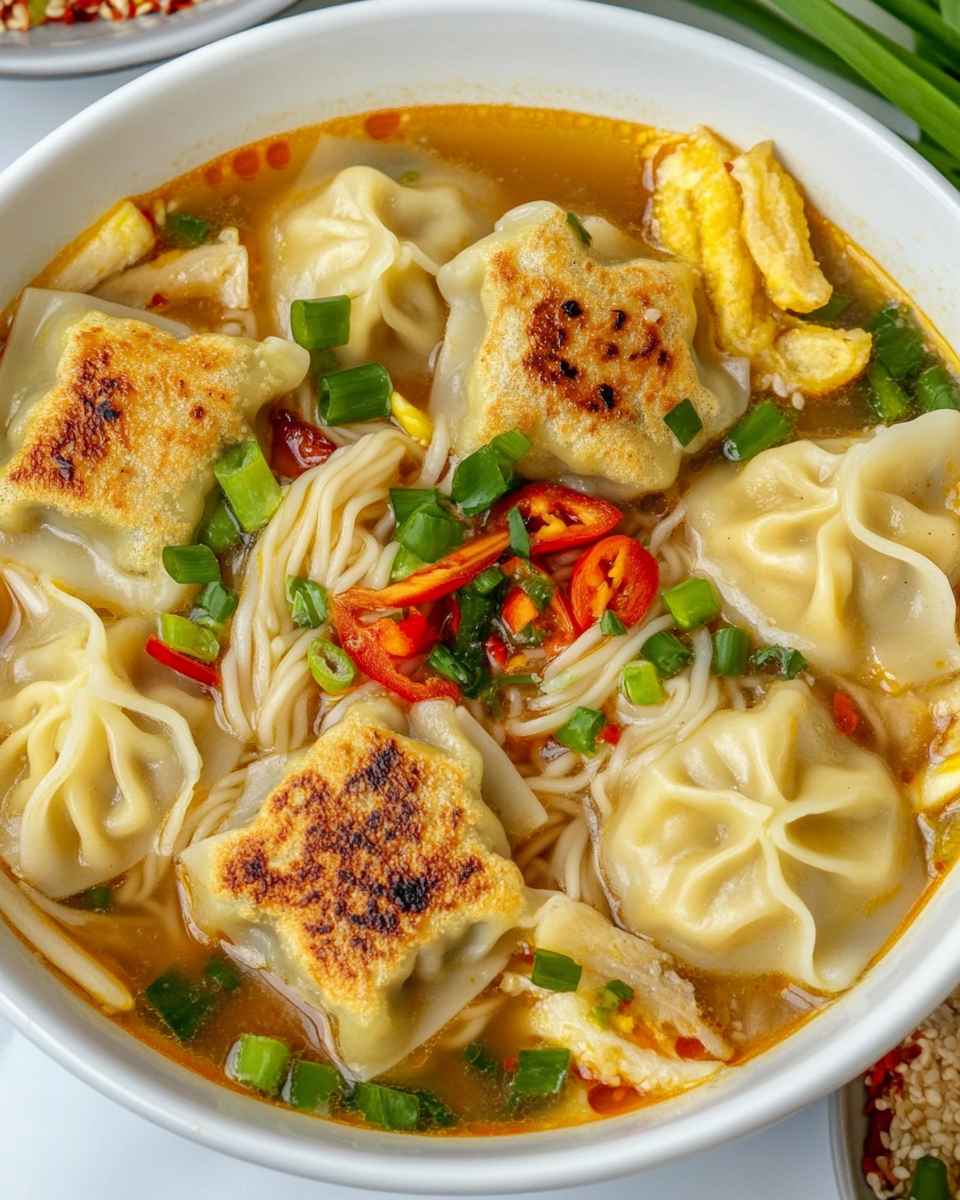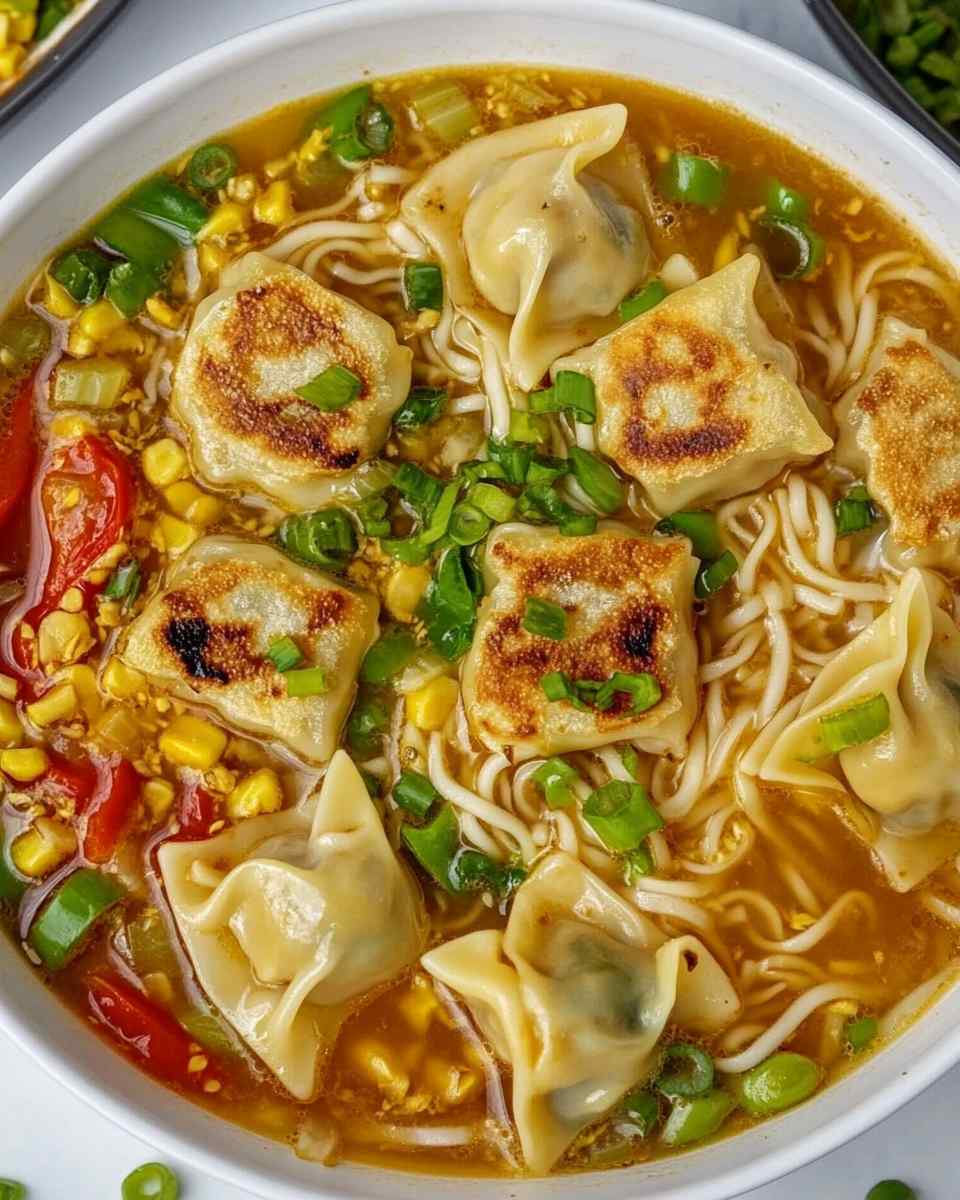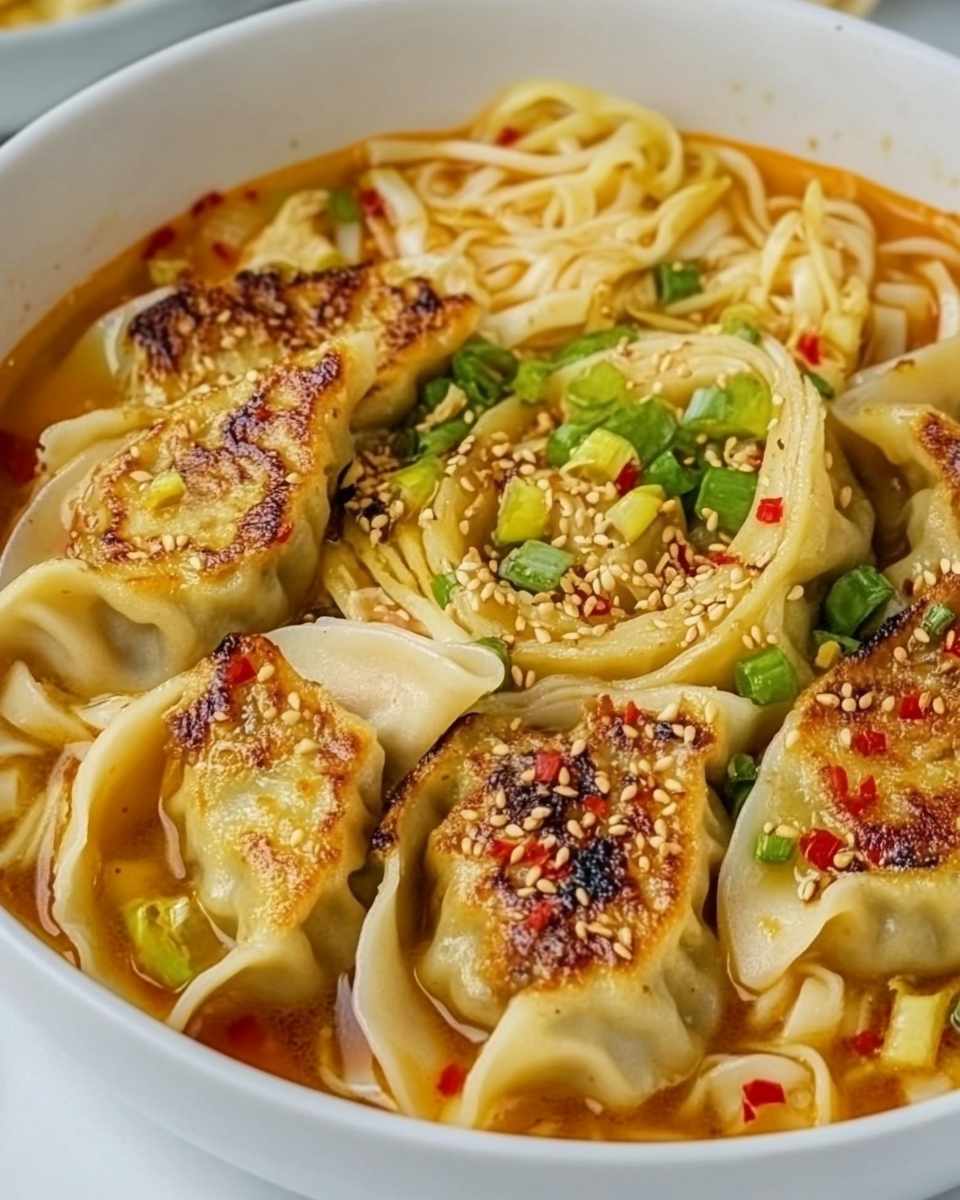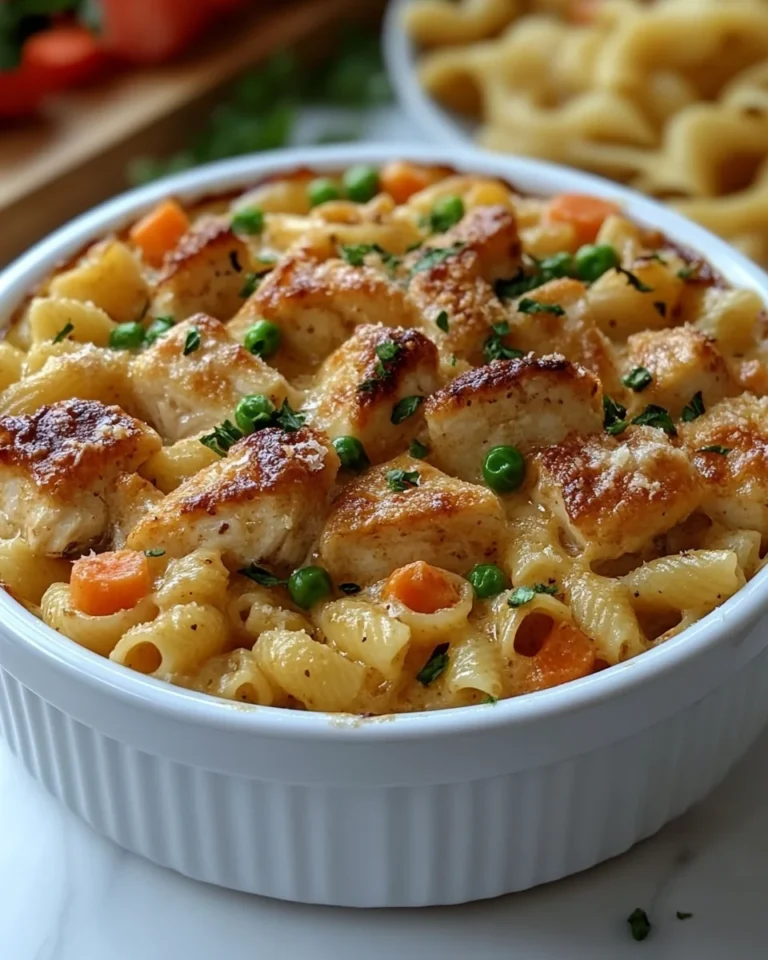Gyoza Noodle Soup
Gyoza Noodle Soup is a comforting and flavorful dish that marries the delightful essence of Japanese dumplings with the warm embrace of a hearty noodle soup. This enticing recipe brings together the savory, umami flavors of gyoza, traditional Japanese dumplings, and the satisfying slurp of noodles in a rich, aromatic broth. With its beautiful presentation and delicious taste, Gyoza Noodle Soup is perfect for cozy dinners or impressing guests at a gathering. The combination of tender gyoza and noodles, complemented by fresh vegetables and aromatic herbs, creates a culinary experience that warms the soul. Whether you’re a seasoned chef or a kitchen novice, this recipe is designed to be straightforward and accessible, making it an ideal choice for any home cook looking to bring a taste of Japan to their table. Let’s dive into this delicious journey and discover how to create your own bowl of Gyoza Noodle Soup!
Why You’ll Love This Recipe?
There are countless reasons to fall in love with Gyoza Noodle Soup, but here are a few that stand out. First and foremost, the taste is a harmonious blend of flavors and textures. The crispy, pan-fried gyoza adds a delightful crunch, while the tender noodles soak up the rich broth, creating a symphony of taste in every bite. Secondly, the preparation of this dish is straightforward and manageable, making it suitable for cooks of all skill levels. With easy-to-follow steps, you can whip up a delicious meal in no time, leaving you free to enjoy the process and the result. Finally, the stunning visual appeal of Gyoza Noodle Soup is sure to impress. The vibrant colors of the fresh vegetables, the golden-brown gyoza, and the steaming broth come together to create a dish that is as pleasing to the eyes as it is to the palate. It’s a meal that invites everyone to the table and encourages a communal dining experience.
Ingredients:

To prepare Gyoza Noodle Soup, you will need a selection of fresh and flavorful ingredients. Each component plays a crucial role in contributing to the overall taste and texture of the soup. Here’s a detailed list of what you will need:
- Gyoza (Dumplings): 12-15 pieces, store-bought or homemade, filled with a mixture of ground chicken or vegetables, cabbage, garlic, and ginger for an authentic flavor.
- Egg Noodles: 200 grams, thin and easy to absorb the broth, offering a satisfying chewiness that complements the gyoza.
- Chicken or Vegetable Broth: 4 cups, a rich base that enhances the flavor of the soup. Opt for low-sodium options to control the saltiness.
- Garlic: 3 cloves, minced, which adds depth to the broth and a fragrant aroma.
- Ginger: 1-inch piece, sliced or minced, providing a zesty kick that balances the richness of the gyoza.
- Green Onions: 2 stalks, chopped, for a fresh and slightly spicy garnish.
- Carrots: 1 medium, julienned, adding sweetness and vibrant color to the dish.
- Bell Pepper: 1 small, sliced, for a crunchy texture and a pop of color.
- Spinach or Bok Choy: 1 cup, wilted in the soup for added nutrition and a burst of green.
- Soy Sauce: 2 tablespoons, to season the broth and enhance the umami flavor.
- Sesame Oil: 1 teaspoon, for a nutty finish that elevates the overall taste.
- Red Pepper Flakes: Optional, for those who enjoy a bit of heat in their soup.
- Lime Wedges: For serving, the acidity brightens the flavors and adds freshness.
These ingredients come together to create a deliciously balanced and satisfying bowl of Gyoza Noodle Soup. Feel free to adjust the quantities based on your preferences or the number of servings needed. Each ingredient contributes uniquely to the overall profile, ensuring that every spoonful is a delight.
How To Make Gyoza Noodle Soup?

Now that you have gathered all the necessary ingredients, it’s time to bring this Gyoza Noodle Soup to life. Follow these detailed step-by-step instructions to create a delicious and satisfying meal.
- Prepare the Gyoza: If using frozen gyoza, follow the package instructions for cooking. Typically, you will pan-fry them in a bit of oil until golden brown, then add water to steam them until cooked through. If making from scratch, prepare your gyoza filling, fill and fold the dumplings, and then cook them as directed.
- Make the Broth: In a large pot, heat a tablespoon of sesame oil over medium heat. Add the minced garlic and ginger, stirring for about a minute until fragrant.
- Add the Broth: Pour in the chicken or vegetable broth and bring it to a gentle simmer. This is where the flavors begin to meld together.
- Incorporate the Vegetables: Add the sliced carrots and bell pepper to the simmering broth. Allow them to cook for about 5 minutes until slightly tender.
- Cook the Noodles: Add the egg noodles to the pot and cook according to the package instructions, usually around 4-5 minutes. Stir occasionally to prevent sticking.
- Add Greens: When the noodles are nearly done, stir in the spinach or bok choy. Cook for an additional minute until wilted.
- Season the Soup: Stir in the soy sauce and taste the broth. Adjust the seasoning as needed, adding more soy sauce or a pinch of red pepper flakes for heat.
- Assemble the Bowl: In a serving bowl, place a few gyoza and ladle the hot noodle soup over them, ensuring to include plenty of vegetables and broth.
- Garnish: Top with chopped green onions and a wedge of lime for squeezing over the soup. The lime adds a refreshing touch.
- Serve: Enjoy your Gyoza Noodle Soup hot, savoring the wonderful combination of flavors and textures.
Follow these steps, and you will have a comforting bowl of Gyoza Noodle Soup that captures the essence of this delightful dish. The key is to balance the broth, gyoza, and vegetables, ensuring a rich and satisfying experience with each bowl served.
Tips For Variations:
While Gyoza Noodle Soup is delicious as is, there are numerous ways to customize it to suit your tastes or to accommodate what you have on hand. Here are some unique substitution ideas for flavor, texture, and budget options:
- Protein Options: Instead of traditional chicken-filled gyoza, consider using shrimp, tofu, or a blend of vegetables. These alternatives can provide a different flavor profile and cater to various dietary preferences.
- Noodle Choices: While egg noodles work beautifully, feel free to experiment with rice noodles, udon, or even soba noodles. Each variety offers a different texture that can enhance your soup.
- Broth Variations: Instead of chicken or vegetable broth, try using miso broth for a deeper umami flavor. You can also make your broth from scratch using kombu (seaweed) and dried shiitake mushrooms for an authentic Japanese taste.
- Vegetable Additions: Mix in other vegetables like mushrooms, zucchini, or snow peas to add variety and nutrition. Each vegetable brings its unique flavor and texture, making the soup more complex.
- Spice It Up: If you love heat, consider adding sliced jalapeños or a dash of chili oil to the broth. For a milder flavor, you can include sweet corn or peas to balance the spice.
- Herbs and Aromatics: Add fresh herbs like cilantro or basil just before serving for a burst of freshness. You can also infuse the broth with lemongrass or star anise to create an aromatic experience.
- Budget-Friendly Options: To keep costs down, use frozen vegetables or gyoza instead of fresh. They can be just as flavorful and often save time in preparation.
These variations allow you to tailor your Gyoza Noodle Soup to your liking, making it a versatile dish perfect for any occasion. Feel free to get creative and mix and match the ingredients based on what you enjoy most or have available.
Serving Suggestions:

When it comes to serving Gyoza Noodle Soup, presentation can elevate the dining experience. Here are some creative serving recommendations to make your meal even more enjoyable:
- Individual Bowls: Serve the soup in individual bowls to enhance the dining experience. This makes it easy for guests to customize their servings with extra toppings like lime or herbs.
- Side Dishes: Pair the soup with a side of Asian-style pickles or a simple salad dressed with sesame vinaigrette. These sides provide a refreshing contrast to the warm soup.
- Condiment Bar: Set up a small condiment bar with options like chili oil, soy sauce, and sesame seeds. This allows guests to personalize their bowls according to their taste preferences.
- Garnish Options: Enhance the appearance of your soup by garnishing with toasted sesame seeds, a sprinkle of furikake (Japanese seasoning), or thinly sliced chili peppers for a pop of color.
- Serving Utensils: Consider using chopsticks for a more authentic experience, along with a soup spoon for enjoying the broth. This adds to the cultural feel of the meal.
- Seasonal Touches: Adapt your serving style to the seasons; in cooler months, consider serving the soup alongside warm, crusty bread or rolls for dipping, while in warmer months, a refreshing fruit platter can complement the meal.
These serving suggestions are designed to enhance your Gyoza Noodle Soup experience, making it not just a meal but a shared moment at the table. The way you present and serve your dish can create lasting memories for everyone involved.
FAQ:
Can I make Gyoza Noodle Soup ahead of time?
Yes, you can prepare the broth and gyoza in advance. Store them separately in the fridge, and assemble the soup just before serving to maintain the noodles’ texture.
What type of gyoza is best for this soup?
Any gyoza filled with ground meat or vegetables can work well. Choose your favorite fillings, whether store-bought or homemade, for a personalized touch.
Can I freeze leftover Gyoza Noodle Soup?
Yes, you can freeze the soup without the noodles. When reheating, add freshly cooked noodles to preserve their texture and flavor.
How do I adjust the spice level?
To adjust the spice level, you can add more or less red pepper flakes or serve with chili oil on the side, allowing guests to customize their experience.
What should I serve with Gyoza Noodle Soup?
Gyoza Noodle Soup pairs well with side dishes like Asian-style pickles, a light salad, or steamed rice, enhancing the overall meal experience.

Gyoza Noodle Soup
Equipment
- Large Pot
- Mixing Bowl
Ingredients
Gyoza (Dumplings)
- 12-15 pieces Gyoza Store-bought or homemade, filled with ground chicken or vegetables.
Noodles
- 200 grams Egg Noodles Thin and easy to absorb the broth.
Broth
- 4 cups Chicken or Vegetable Broth Opt for low-sodium options.
Aromatics
- 3 cloves Garlic Minced.
- 1 inch Ginger Sliced or minced.
Vegetables
- 2 stalks Green Onions Chopped.
- 1 medium Carrot Julienned.
- 1 small Bell Pepper Sliced.
- 1 cup Spinach or Bok Choy Wilted in the soup.
Seasoning
- 2 tablespoons Soy Sauce To season the broth.
- 1 teaspoon Sesame Oil For a nutty finish.
- to taste Red Pepper Flakes Optional, for heat.
Serving
- 1 wedge Lime For serving.
Instructions
- Prepare the Gyoza: Cook frozen gyoza according to package instructions or make from scratch.
- Make the Broth: Heat sesame oil in a large pot, add minced garlic and ginger, and stir until fragrant.
- Add the Broth: Pour in the chicken or vegetable broth and bring to a gentle simmer.
- Incorporate the Vegetables: Add sliced carrots and bell pepper, cooking for about 5 minutes.
- Cook the Noodles: Add egg noodles and cook according to package instructions, about 4-5 minutes.
- Add Greens: Stir in spinach or bok choy and cook for an additional minute.
- Season the Soup: Stir in soy sauce and adjust seasoning as needed.
- Assemble the Bowl: Place gyoza in a serving bowl and ladle hot noodle soup over them.
- Garnish: Top with chopped green onions and a wedge of lime.
- Serve: Enjoy your Gyoza Noodle Soup hot.







